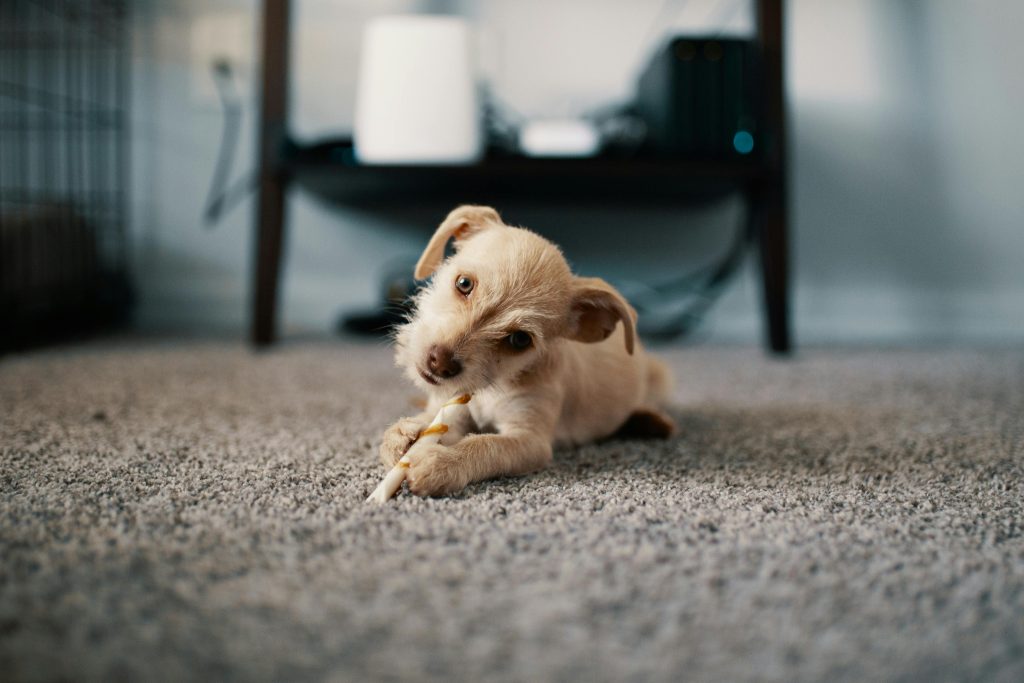-
Important Things to Know on Your Puppy’s First Day Home
Get Prepared:
Before choosing a puppy, it’s crucial to understand the temperament and habits of different breeds. Preparation is key—make sure you have the essentials ready, including a crate, food bowl, water bowl, and toys. These items should be clean and of good quality to meet your puppy’s basic needs.Crate Training Is Recommended:
When bringing your puppy home, it’s a good idea to start with crate training. This helps your puppy get plenty of rest and prevents unwanted chewing. A properly used crate gives your puppy a sense of personal space and security, which can also reduce separation anxiety.Puppy Barking:
It’s normal for a puppy to bark or whine a lot during the first couple of days. You can use a blackout curtain or breathable fabric to partially cover the crate, leaving the side against the wall uncovered for ventilation. This setup helps the puppy feel more secure. If your puppy barks, don’t respond right away. Wait until they’re quiet, then reward the calm behavior. In most cases, the barking will significantly decrease after about a week.Outdoor Guidelines:
Always use a leash when walking your puppy to keep them safe. Limit walks to about 30 minutes a day. Avoid walking your puppy immediately after meals, as it may lead to gastric torsion. During hot weather, walk your puppy in the early morning or late evening to prevent heatstroke.Cleaning Tips:
It’s normal for puppies to have a bit of odor or dirt when they first arrive. Don’t rush to give them a bath right away—bathing too soon can cause a cold or expose them to infections. Instead, use no-rinse grooming gloves or wipes to gently clean them. Bathing frequency should be about once every 2 weeks in spring and summer, and once every 4 weeks in fall and winter.
-
Puppy Health Care Essentials
Vaccinations:
Vaccines play a vital role in protecting your puppy from deadly diseases like canine distemper. One vaccine is essential for preventing infectious diseases such as distemper and parvovirus, and the other is for rabies, which is required in many regions by law.Vaccination Schedule:
Puppies should receive their first round of vaccinations at 6–8 weeks old. In the first year, your puppy will typically need three core combination shots (DHPP or 5-in-1) and one rabies shot, spaced 3–4 weeks apart. After the first year, your dog will need annual boosters for both the combo vaccine and rabies.Tips for Vaccination:
If you’ve just brought your puppy home, it’s best to observe them for one week before starting vaccinations. After completing all vaccines, consider a titer test to check antibody levels and confirm vaccine effectiveness.Internal & External Deworming:
Puppies can easily get parasites by interacting with other dogs or eating contaminated food. Since young dogs have weaker immune systems, parasite infections can be especially dangerous.Common parasites include external pests like fleas, lice, mites, and ticks, as well as internal parasites like heartworms, roundworms, hookworms, and whipworms.
-
Fleas and lice can cause severe itching and skin irritation.
-
Ticks feed on blood and may carry diseases.
-
Hookworms and roundworms can lead to weight loss and bloody stools.
-
Heartworms are particularly deadly—treatment is expensive, complicated, and often has a low success rate.
Regular deworming is the best way to keep your puppy safe. Choosing the right deworming medication is essential. Look for products backed by reputable brands, with stable quality and a proven safety record.
-
-
Puppy Feeding Guidelines
Feeding Basics:
For puppies under 3 months old, dry kibble should be softened with puppy formula (goat milk powder) before feeding. When switching to a new type of dog food, follow the 7-day transition method: gradually increase the new food while decreasing the old food over the course of a week. Always feed your puppy on a regular schedule, in measured portions, and ensure they have fresh water available at all times.Feeding Amount Recommendations:
The recommended daily food intake is around 2.5% to 4% of your puppy’s body weight (in kilograms).
For example, if your puppy weighs 10 kg, you should feed 250g to 400g per day, depending on their digestion.If your puppy’s stool is too hard, slightly increase the food amount.If the stool is too soft, reduce the portion size a bit.
-
Puppy Socialization & Training Basics
The Critical Training Window:
The period between 2 to 6 months old is considered the golden window for puppy training. At this stage, your puppy’s ability to learn is at its peak.
That said, this doesn’t mean you can’t train them later—it just means starting early gives better results.Training Timing:
Let your puppy out of the crate about 1 hour before mealtime for some playtime. Puppies are usually overly excited right after being let out, which makes them hard to focus. Let them play for about 30 minutes, then begin training. When slightly hungry, your puppy will be more motivated by food-based rewards.Training Frequency:
For puppies under 3 months old, keep each training session short—about 15 minutes, and aim for twice a day.
Once your puppy is over 3 months, you can start to increase training frequency and introduce more structured reward systems.

